Week 1 of 8: How to Benchmark Your Swimming
In Summary (TL;DR)
This is Week 1: how to benchmark where you're at
Introducing you to a new way for you to consume as much (or as little) of our content as you need
Get some real-world tidbits from the Sw-improvers on how they went with their own benchmarking to encourage you with yours!
VIDEO: how to know if the 2-beat kick is right for you.
Q: How did you get on setting your improvement intentions last week?
Was it difficult to put it all down on ‘paper’?
G.U.R.U
Now, you may or may not have realised this, but the Swim Smooth GURU is actually a mnemonic for: Guiding all swimmers, triathletes and their coaches towards a more aware Understanding of how to improve and enjoy their daily swimming Routines and rituals with the Ultimate in individualised swim coaching experiences 👍.
Taking onboard your varied and generous feedback a couple of weeks ago has allowed us to structure the blog going forwards into bite-size chunks. This will allow you to go from quickly getting a jist of what to focus on for the week, seeking to take a deeper dive into the ‘why’, practically applying this advice by following our suggested session or activity for the week, right through to seeing how our 8 lucky swimmers are getting on with their ultimate coaching experience.
So here goes for Week 1: benchmarking:
Guidance
Simple pointers for all swimmers, triathletes and their coaches
You've perhaps heard the term:
“What gets measured, gets managed”
It was attributed to Peter Drucker (1909-2005), the brilliant management theorist, but apparently he never said it.
V.F Ridgeway was critical of this statement in a 1956 paper he wrote, instead stating that,
“Not everything that matters can be measured. Not everything that we can measure matters.”
This tallies with the task I set you last week of defining subjective and objective goals respectively.
Still, despite many of us saying that we “don't care about the time" (just about how we feel), ultimately we all judge improvement to some extent by some objective measure like the time it takes us to swim X distance. As such, setting a benchmark of some sort is important if we want to measure the effect of any intervention we are applying.
Understanding
Deeper insight into how to improve this aspect of your swimming
The benchmark we have historically - and successfully - used for many years here at Swim Smooth is Critical Swim Speed (CSS).
For some people, the mere mention of a time trial to determine where you're at can be enough to turn you right off and stop reading this blog immediately…well, did you?! 🤣
A CSS test allows us to identify one singular number that we can use to effectively set appropriate training paces for a range of distances, session types, and of course, for a wide variety of swimming abilities too.
The entire success of the smooth operation of our squads globally - each session tailored to the needs of the individual - can be tied to the fact that our Swim Smooth Coaches all know their swimmer's CSS paces off the top of their heads and can ‘seed’ them accordingly within the correct lane(s). This ensures each swimmer is getting a productive session appropriate for them. When combined with our Red Mist Cycles as well (which we'll get into further into this blog series), this allows us to standardise the training session across the squad such that every swimmer is getting the same physiological effect from the session and not just ‘rounding up’ for ease of using the clock.
Here's how CSS training works:
Routine
Actionable advice with a practical program that works
So, your task this week, is to bite the bullet and go and do a CSS test to benchmark where you're at.
Only by truly testing (and not being afraid to test yourself) can you faithfully say whether you have improved or not following a dedicated intervention period.
To do so, follow the instructions below, which will work in a meters and yards pool equally well:
warm-up for about 10-15 minutes including some of your favourite drills.
do 2 to 4 x 100 at the pace you think you are capable of sustaining for the 400 time trial. Take 20 seconds rest between. Closely monitor how well you're pacing yourself - better to get your pacing wrong here than during the test.
now do a well-paced 400 time trial, preferably getting a split time at the 100 mark if you can. Make a note of these times after you've caught your breath back.
take an easy 5-8 minutes swim to loosen off.
now do a well-paced 200 time trial. Make a note of this time.
finish off with an easy cool down and you're done.
now visit our new CSS Calculator*, complete with advice on your pacing, suggestions of pacing for a 10 week incremental program, performance predictions and your Red Mist Cycles:
*with the imminent re-release of the GURU we shall be restricting some of these results to one of 3 new great value payment levels, so make sure you get in quick before we make those changes!
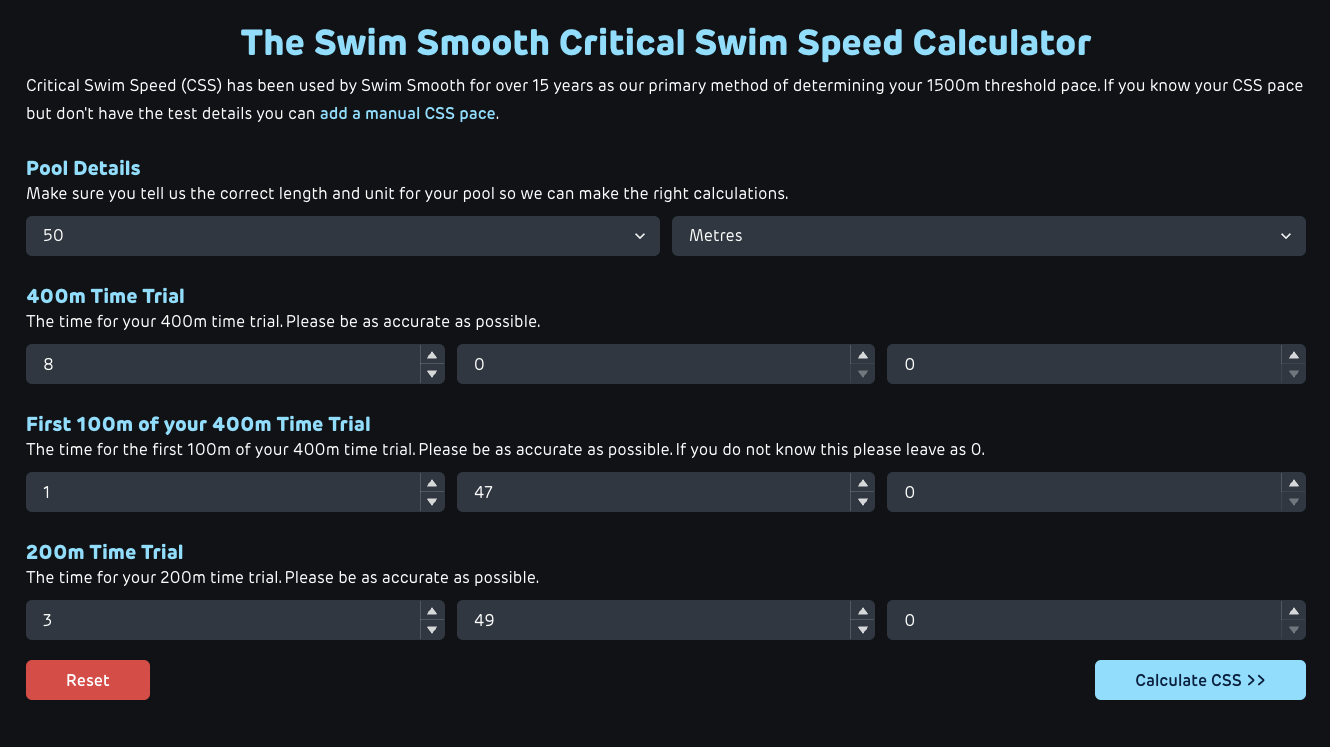
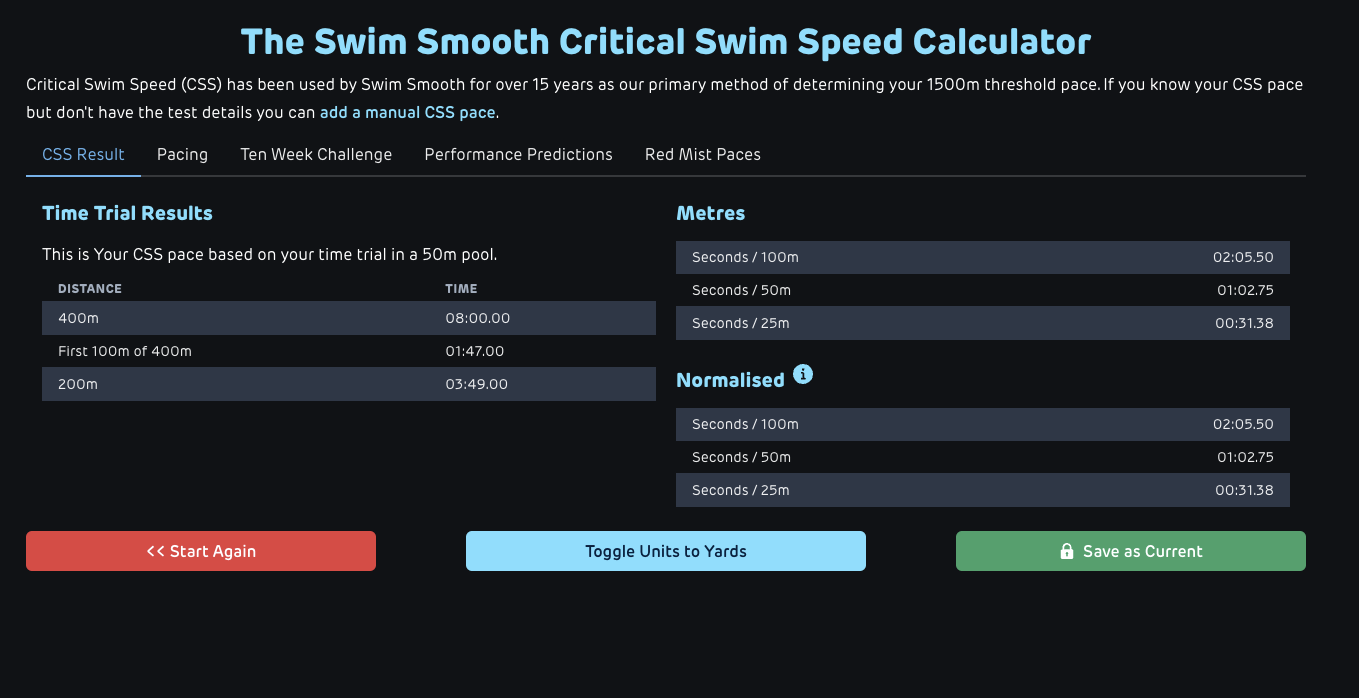

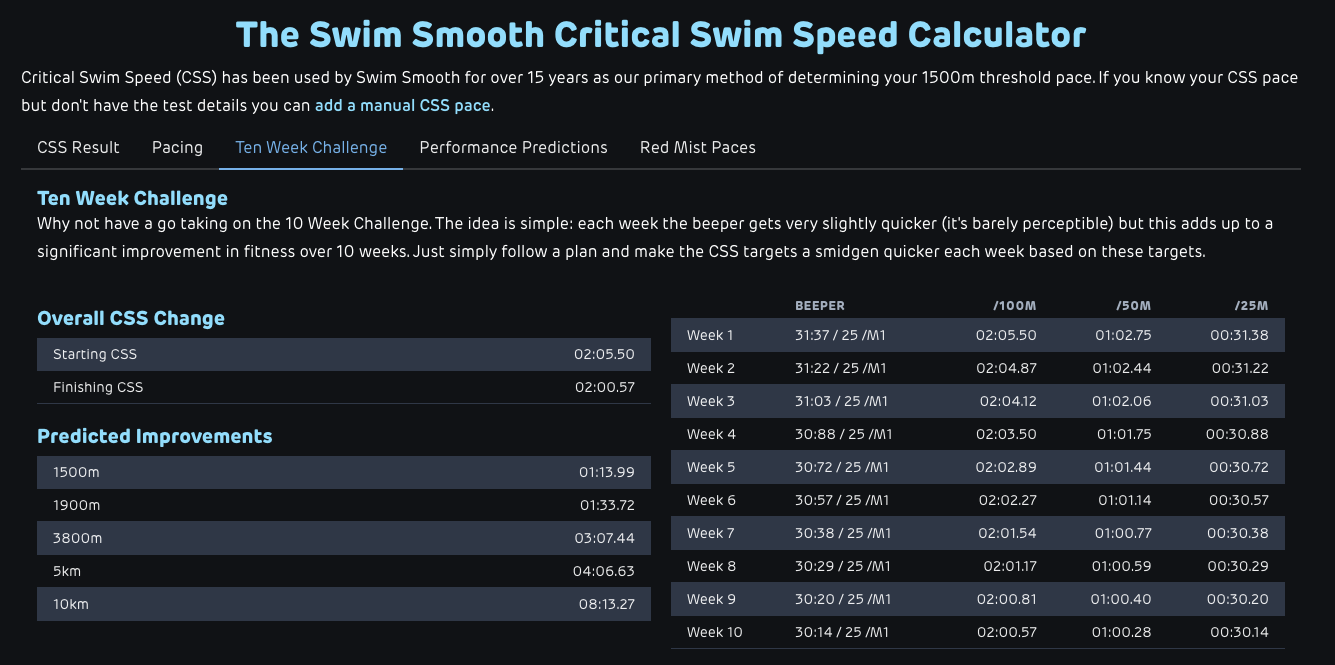
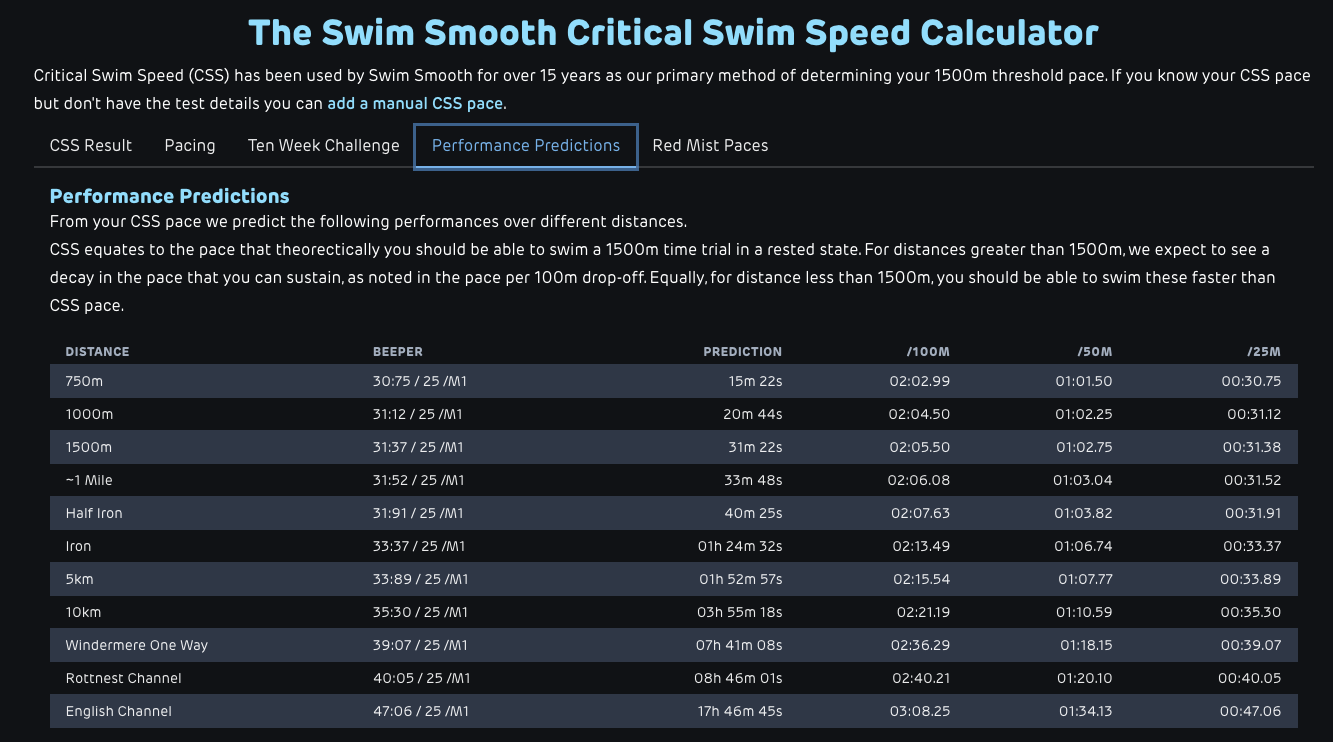
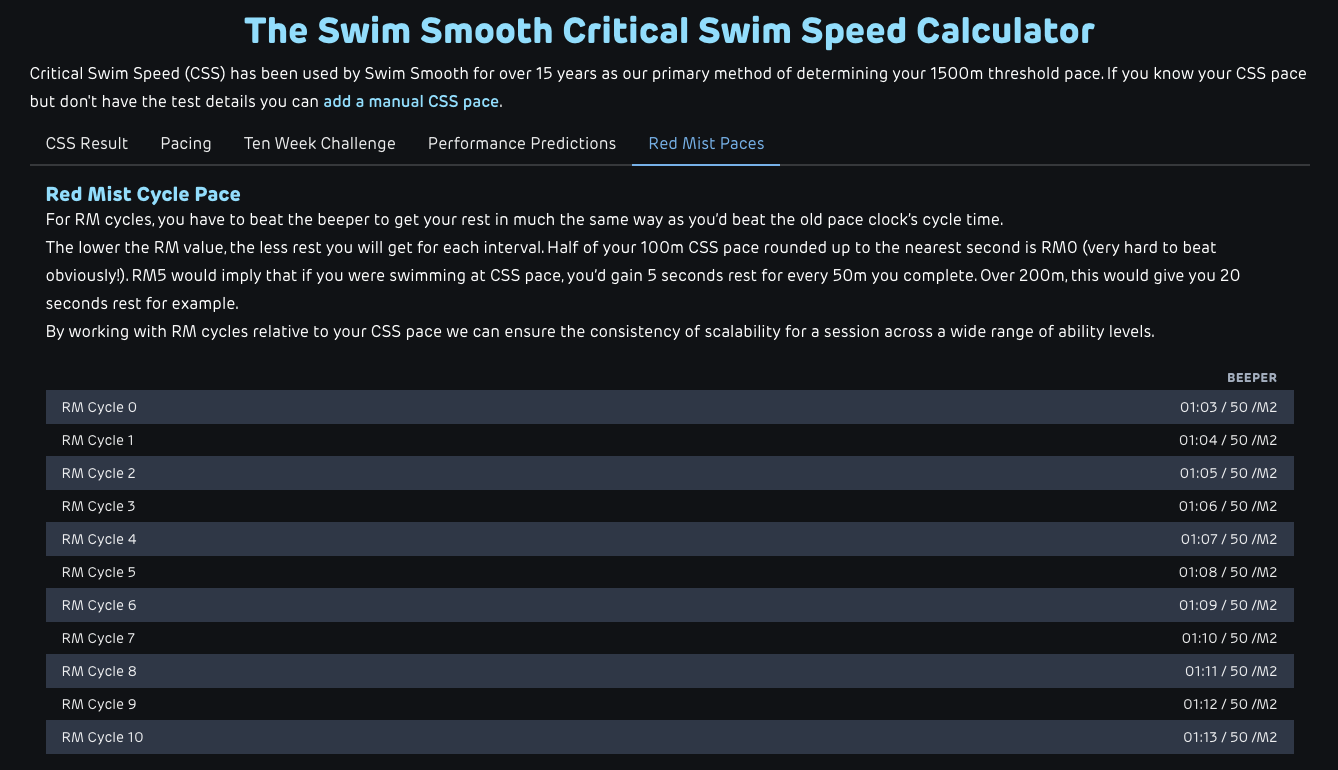
🧐 But What If I Can't Swim 400m?
Fear not! If you can't complete the CSS Test as outlined above, why not set yourself your own benchmark this week? It could be that you'll aim to swim 4 lengths continuously, or just make it down and back without needing to break into breaststroke, or that you were able to swim 15 minutes without stopping. Whatever it is, test it this week and make a note of where you're at - that's all this is about 👍
Ultimate
Nothing beats direct - and truly individualised - coaching from one of our Swim Smooth Coaches
Sw-improvers:
Let's now meet our 8 “guinea pigs" (we'll refer to them as our “Sw-improvers”), learn briefly about their goals and see the results of their CSS test earlier this week.
Each of these swimmers has been invited to join an exclusive group of 8 who we will be tracking their progress of each week, culminating in a remote video analysis with myself at the end of the 8 weeks. This is very much the kind of personal 1-2-1 coaching service that all our Swim Smooth Coaches offer, and well worth checking out.
We've created a special WhatsApp group where I'll be sending them the coaching instructions for the week ahead of time and then reporting back so you can see how they go.
💡 See who you relate most closely to and follow them specifically as we aim to truly show you the ups/downs of improvement and what it feels like.
Wendy, 55 from Oxford in the UK, offered you all some sage advice:
“Use the CSS test as a time to really focus on your swim. You've committed to the process to improve your technique and this is just a benchmark to use to see improvements and build on. Trust the process!”
And this nugget from David, 46, in Belgium:
“You do get better at the CSS tests the more you do them. I remember my first one: went all out from the start, was exhausted after 150 meters and just barely survived the rest of the test. Now I start with a solid, but doable pace, having a better feel for the length of the test and also for my own capacity to sustain.”







